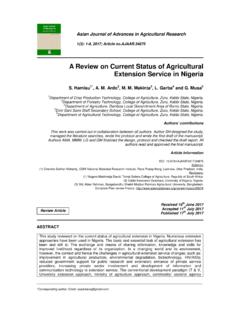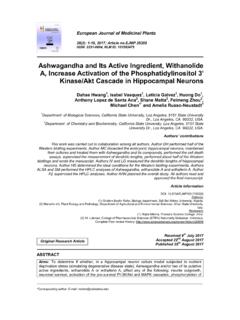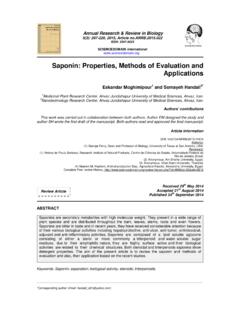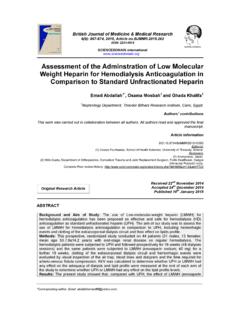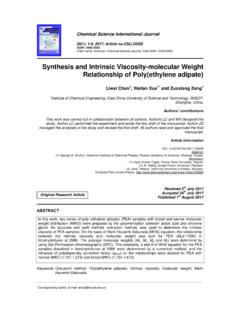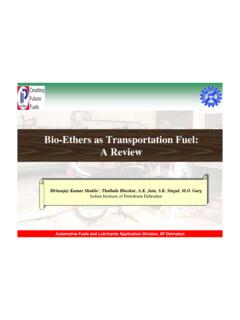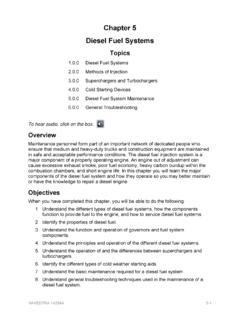Transcription of A Review on Bio- And Adsorptive Desulfurization of Diesel Fuel
1 _____ *Corresponding author: E-mail: Journal of Scientific Research & Reports 11(3): 1-6, 2016; Article ISSN: 2320-0227 SCIENCEDOMAIN international A Review on Bio- And Adsorptive Desulfurization of Diesel fuel Mojirade M. Oloruntoba1,2*, D. S. Aribike2 and S. C. U. Nwachukwu3 1 Prototype Engineering Development Institute (PEDI), Ilesa, Nigeria. 2 Department of Chemical and Petroleum Engineering, University of Lagos, Akoka, Lagos, Nigeria. 3 Department of Botany and Microbiology, University of Lagos, Akoka, Lagos, Nigeria. Authors contributions This work was carried out in collaboration between all authors. Author MMO did the literature searches, designed the study, wrote the protocol and the first draft of the manuscript. Author DSA also contributed and managed the literature searches.
2 Authors DSA and SCUN supervised the study. All authors read and approved the final manuscript. Article Information DOI: Editor(s): (1) Masafumi Tateda, Department of Environmental Engineering, Graduate School of Engineering, Toyama Prefectural University, Japan. Reviewers: (1) Linfeng Yang, University of Alberta, Edmonton, Canada. (2) Shengqiang Wang, Nankai University, China. (3) Timur Bilalov, Kazan National Research Technological University , Kazan, Russia. Complete Peer Review History: Received 10th May 2016 Accepted 23rd June 2016 Published 1st July 2016 ABSTRACT Aims: To Review some previous work on biodesulfurization and Adsorptive Desulfurization of Diesel fuel . Study Design: The emissions from fossil fuels have been established to be a major contributor to global warming and acid rain which deteriorates the environment and infrastructures.
3 In refineries, hydrodesulfurization (HDS) method is currently used to remove thiols, sulfides and thiophenes compounds present in lower-boiling petroleum fractions, but the removal of benzothiophenes (BT) and dibenzothiophenes (DBT) contained significantly in middle-distillate petroleum fractions (MDPF) , Diesel via HDS is difficult due to the presence of substitutions which are believed to sterically hinder access of the sulfur atom to the catalyst surface. Over the years there have been several regulatory standards and researches on limiting the sulfur content of petroleum products. The development of complimentary Desulfurization techniques that will remove these recalcitrant compounds from the MDPF is therefore essential. Biodesulfurization (BDS), a process in which Mini- Review Article Oloruntoba et al.
4 ; JSRR, 11(3): 1-6, 2016; Article 2 sulfur is removed from a substance by an enzymatic process yielding sulfate or sulfide as a product; and Adsorptive Desulphurization (ADS), a process which removes sulfur from a substance through the use of adsorbents are amongst the complementary methods being explored for the removal of sulfur present as DBT in MDPF. Methodology: The Review highlights the study by some listed authors on biodesulfurization and Adsorptive Desulfurization of Diesel fuel respectively. Results: The potentiality of ADS using different types of adsorbents are continuous area of research as little or no report of their commercialization has been reported. Also, for the BDS, most research focus has been on aerobic Desulfurization with currently little evidence for the potentiality of a commercially significant anaerobic Desulfurization .
5 Conclusion: The current trends toward stricter regulations on the content of sulfur in fuels provide enough incentive for the continued search for improved complementary Desulfurization technique. Keywords: Biodesulfurization; Adsorptive Desulfurization ; dibenzothiophenes; Diesel fuel . 1. INTRODUCTION The combustion products from fossil fuels are harmful to the environment. Carbon dioxide emissions have been established to be a major contributor to global warming. Sulfur and nitrogen oxides emissions are pollutants which have been shown to be responsible for acid rain, which deteriorates the environment and infrastructures [1]. Governments throughout the world have recognized the problems associated with these emissions and are taking steps to reduce them through legislations.
6 Environmental agencies are also imposing more stringent regulatory standards on the sulfur content of petroleum products. Sulfur is present in crude oil as hydrogen sulfide (H2S), as organosulfur compounds or as elemental sulfur, S, with concentration typically between and (by weight), although values as high as have been reported. In general, the distribution of sulfur in crude oil is such that the proportion of sulfur increases along with the boiling point of the distillate fraction. As a result, the higher the boiling range of the fuel , the higher the sulfur content will tend to be. For example, a middle-distillate-range fraction like Diesel fuel will typically have higher sulfur content than the lower-boiling-range fraction like gasoline.
7 Also, the proportion, stability and complexity of sulfur compounds are greater in heavier crude oil fractions [2]. In refineries organic sulfur are removed from crude oil-derived fuels by HDS. HDS is a catalytic process that converts organic sulfur to hydrogen sulfide gas by reacting crude oil fractions with hydrogen at pressures between MPa and MPa and temperatures between 290 C and 455 C, depending upon the feed and level of Desulfurization required [3]. Organic sulfur compounds mainly thiols, sulfides, and thiophenes in the lower-boiling fractions of petroleum, , the gasoline range, are readily removed by HDS. However, middle-distillate fractions, , the Diesel range, contain significant amounts of BT and DBT, which are recalcitrant and comparatively more difficult to remove by HDS.
8 Among the most refractory of these compounds are DBT with substitutions adjacent to the sulfur component. Due to their resistance to HDS, these compounds represent a significant barrier to reaching very low sulfur levels in middle-distillate-range fuels [4]. There is therefore the need for complementary method for the removal of these refractory compounds. BDS and ADS are amongst the complementary methods being explored. 2. Review During the past decade, many countries have imposed a reduction of sulfur level to 10 ppm fuels, to reduce harmful emissions from the combustion of fuel . In the European Union, the standard "Euro V", which specifies a maximum of 10 ppm sulfur in Diesel fuel for most road vehicles, has been applied since 2009.
9 In Russia, the formal technical requirements for fuels were introduced by Government Decree No. 118, " technical Regulation on requirements for automotive and aviation gasoline, Diesel and marine fuel , jet fuel and heating oil." Three automotive standards cover fuel quality: Type I (Euro 3), Type II (Euro 4) and Type III (Euro 5) with a sulfur content of 350 ppm, 50 ppm and 10 ppm, respectively. The quality of Diesel fuels in the US has been specified by ASTM D975, which covered seven qualities Diesel fuel oils for different types of Diesel engines; since 2010, ultra-low sulfur Diesel (ULSD) with a sulfur Oloruntoba et al.; JSRR, 11(3): 1-6, 2016; Article 3 content of 15 ppm, is the new standard for all on-road Diesel fuel while non-road Diesel engine fuel also move to ULSD in 2014.
10 This makes Review of Desulfurization of fuel interesting and useful for researches in the field. This study is limited to the Review of some work that has been done on BDS and ADS. BDS is a process in which sulfur is removed from a substance by an enzymatic process yielding sulfate or sulfide as a product [5]. During a BDS process, alkylated dibenzothiophenes (Cx-DBTs) are converted to non-sulfur compounds, for example, 2-hydroxybiphenyl (2-HBP) and sulfate. Whereas, ADS is a process that depends on the ability of an adsorbent to selectively adsorb organo-sulfur compounds. It is based on selective adsorption of such compounds onto tailored surfaces which are employed as adsorbents. It is an efficient process yielding clean fuel free from sulfur under modest process conditions by utilizing absorbent materials known to be multifunctional in terms of structural, textural and surface properties to match the requirement for the adsorption of sulfur containing compounds including refractory compounds.
